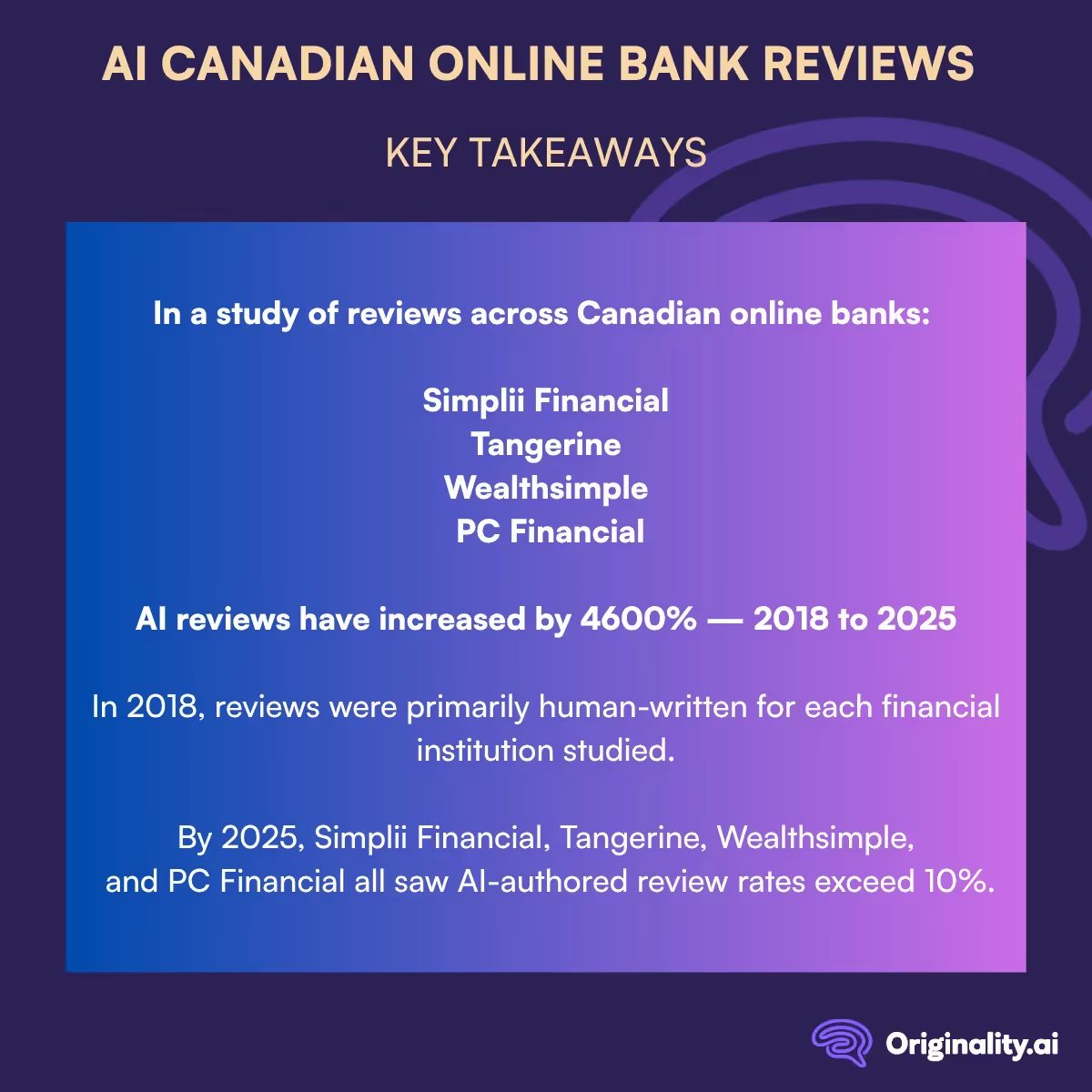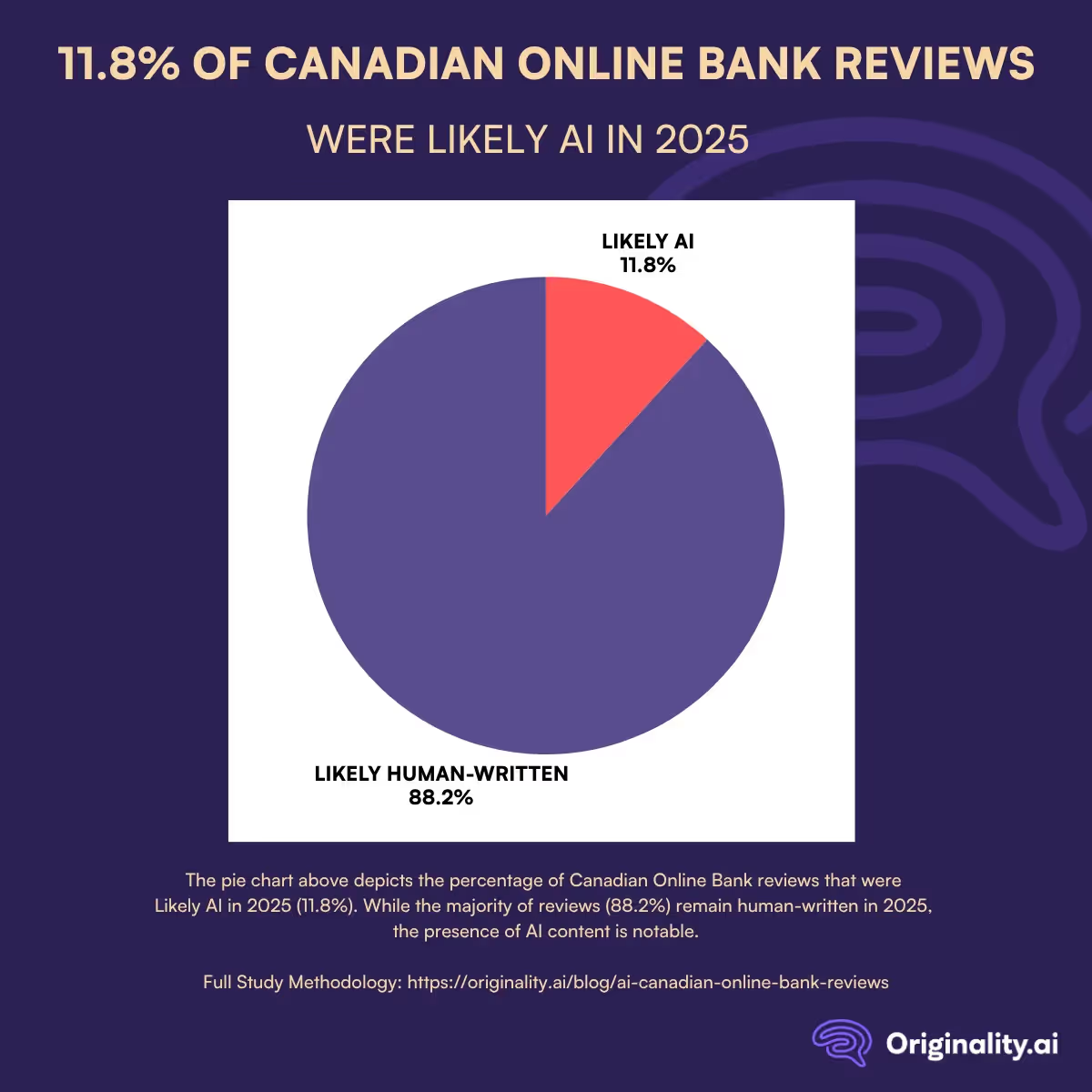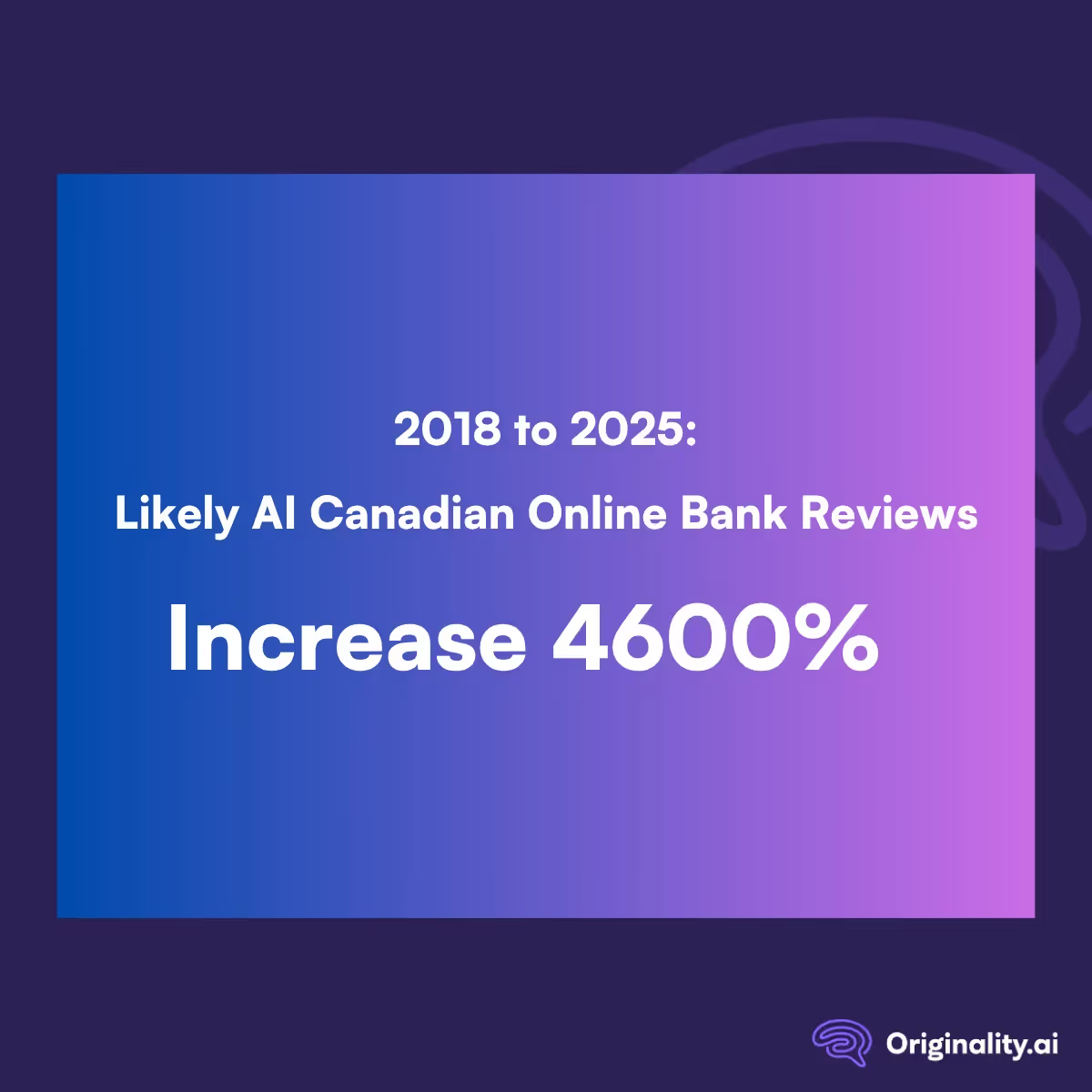In recent years, the financial services landscape has undergone a profound transformation driven by advances in artificial intelligence (AI).
From algorithmic trading to customer service chatbots, the use cases for AI have continued to expand, and nowhere is that more visible than in the realm of online customer reviews.
As major Canadian online banks strive to enhance their digital footprints and differentiate themselves in a competitive market, customer feedback has become a critical barometer of both brand reputation and service quality.
Yet, the rise of sophisticated text-generation models raises an important question: to what extent are “customer” reviews genuinely the product of human experience, and how much are being authored or heavily edited by AI?
In this study, we investigated the prevalence of AI reviews for Canadian online banks — Simplii Financial, Tangerine, Wealthsimple, and PC Financial — from 2018 to 2025.
This study examines the prevalence of AI-generated reviews across four leading Canadian online banking platforms, Simplii Financial, Tangerine, Wealthsimple, and PC Financial, from 2018 to 2025.
Leveraging our proprietary Originality.ai AI detection tool, we analyzed reviews to determine whether they were human-written or AI-generated. Then, we calculated annual rates of AI-authored content for each noted financial institution.
Interested in learning more about the impact of AI on the Canadian financial services sector? Read our analysis of AI Canadian “Big 5” bank reviews.


From 2018 to 2025, the prevalence of AI-generated reviews across these four Canadian online banks rose sharply.
In 2018, reviews at the Canadian online banks studied were primarily human-written:
Only Tangerine registered a non-zero rate of AI reviews (1.0%) in 2018, while Simplii Financial, Wealthsimple, and PC Financial all began at 0.0% AI-generated reviews.
By 2025, each institution — Simplii Financial, Tangerine, Wealthsimple, and PC Financial — saw its AI-authored review rate exceed 10%.
Averaging across all four banks, the mean AI review rate:
Notably, there was a range of changes in AI levels across the institutions. Wealthsimple saw an early uptick in AI reviews around 2021, while Tangerine and Simplii Financial exhibited more gradual rate increases.
Bank-by-bank analysis demonstrated that:
This range of changes suggests that, although all of the studied Canadian online banks have been affected by the surge in synthetic content, certain banks (such as Simplii Financial) have encountered a higher influx of AI-authored feedback.

Early in the period studied (2018), AI-authored content was low or zero, prior to the launch of mainstream AI tools like ChatGPT (in 2022).
However, by 2025, there was a marked increase in AI-generated review rates to an average of almost 12%.
This signals a clear shift in the dynamics of online customer feedback for Canadian digital banks.

These findings underscore a broader industry trend: as text-generation tools have matured, AI-generated reviews have proliferated on financial services platforms.
Canadian online banks now contend with more than one in ten reviews being flagged as AI-authored, a stark contrast to the near-absence of synthetic reviews
For banks, this trajectory highlights the urgent need to bolster review-moderation protocols, incorporate AI detection, and educate customers about the distinction between genuine and AI-assisted feedback.
From a consumer-trust perspective, the rising prevalence of AI-generated reviews presents a two-fold challenge.
First, genuine customers may find it increasingly difficult to differentiate between authentic experiences and AI-crafted testimonials (especially considering studies have shown humans struggle to identify AI), potentially undermining confidence in both the review ecosystem and the institution.
Second, banks may be met with reviews that do not correspond to actual service improvements, skewing their internal performance metrics and strategic decision-making.
To mitigate these risks, financial institutions should transparently disclose their review-moderation practices and incorporate AI detection.
Our analysis of AI-generated review rates across four major Canadian online banks reveals a pronounced industry-wide escalation of synthetic feedback.
As of 2025, more than one in ten Canadian online bank reviews is flagged as AI-authored, with individual institutions’ AI review levels ranging from approximately 11% to 14%.
These findings highlight the urgent need for banks to strengthen AI detection frameworks and communicate clearly with customers about review integrity.
Ultimately, maintaining trust in online reviews will require an ongoing commitment to AI-detection strategies and transparent engagement with all stakeholders in the digital feedback ecosystem.
Wondering whether a post or review you’re reading might be AI-generated? Use the Originality.ai AI detector to find out.
Read more about the impact of AI:
This study analyzed AI-generated customer reviews among Canada's main online banks — Wealthsimple, Simplii Financial, Tangerine, and PC Financial — using web scraping and AI detection tools.
Customer reviews were collected using Python scripts with BeautifulSoup and Requests libraries from platforms like ConsumerAffairs and Trustpilot. The data, including review content and dates, was saved in CSV format.
Reviews with 50+ words were analyzed using the Originality.ai API. An automated script sent review data for analysis, returning AI likelihood scores and binary classifications (AI or human). The script included error handling and retry features for reliability.
Results, including dates, bank names, review texts, and AI scores, were logged and saved periodically. Final datasets were compiled into CSV files for trend analysis from 2018 to 2025.
This method ensured reliable identification of AI-generated reviews, supporting a deeper analysis of trends in Canadian online banking.
